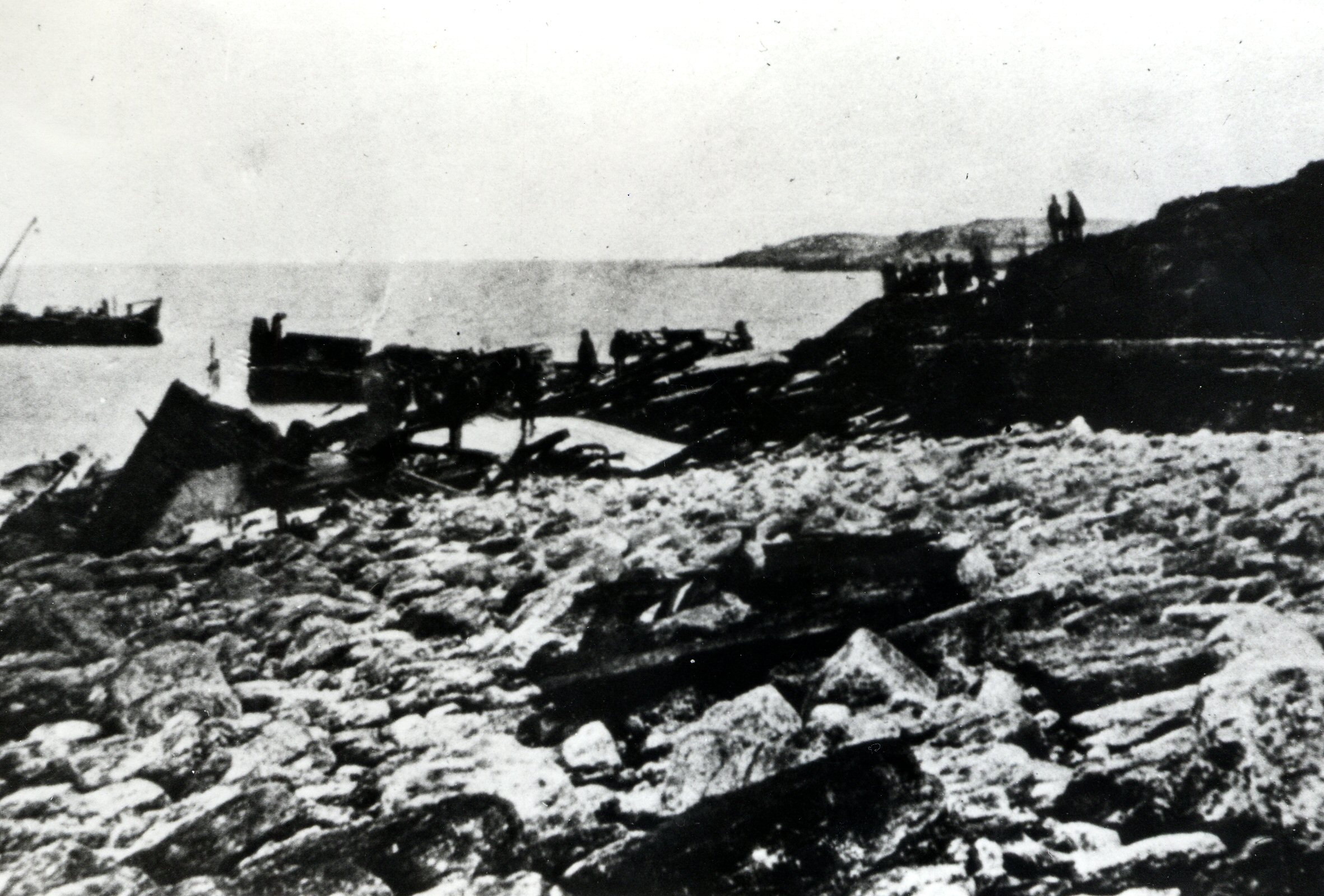Gellir lawrlwytho cynnwys at ddefnydd anfasnachol, megis defnydd personol neu ar gyfer adnoddau addysgol.
Ar gyfer defnydd masnachol cysyllwch yn uniongyrchol gyda deilydd yr hawlfraint os gwelwch yn dda.
Read more about the The Creative Archive Licence.
Disgrifiad
The picture shows the wreck of the Royal Charter which was washed ashore near Moelfre, Anglesey in October 1859. The ship had been sailing for Liverpool from Melbourne, Australia, with a cargo of gold and over 400 passengers on-board when she was caught in a great storm and blown onto the rocks. The Royal Charter was an iron hulled hybrid steam ship over 300ft long.
The storm had been so powerful that the iron hull of the Royal Charter had broken in two. It had initially been pushed by the winds and waves parallel to the shoreline, but had then snapped in the middle. The two halves of the ship began to rotate, with bow and stern facing the land and the exposed interior of the ship facing the oncoming waves and wind. Crashing waves flooded into the interior sections of the ship, washing out into the stormy seas all those inside.
The passengers of the ship, particularly women and children had been ordered to stray below in the saloon to wait a time when they could be carried ashore by a hawser that was being set up. There were some 200 people amidships when it broke in two. Owen Williams was sent below to fetch them up when all was ready, but was unable to reach them as the ship had broken in two before he arrived. As the water came flooding in the passengers panicked and fled to the upper decks, some only to be washed overboard by the giant waves crashing over the ship.
Following the wreck an inquiry was held by the Board of Trade in the Crown Court of St. George's Hall Liverpool, where the survivors of the Royal Charter, its owner, and those who had built it were all called to give evidence to explain the disaster. One of the key elements that were being discussed was the safety and suitability of iron ships.
The use of iron in the manufacturing of ships could be dated as far back as 1787 with the creation of metal barges, but it was not until the 1840's that iron came to be used as the primary construction material, and it did no replace wooden ships until the 1870's. Iron ships were then in 1859 still quite new inventions and had yet to stand the test of time. New problems were appearing with the new technology and solutions had to be found for them. Victorian society had marvelled at its engineering achievements, and many letters were written to the Board of Trade demanding an explanation for why an iron ship such as the Royal Charter might have failed.
There had been much debate over the safety and ability of iron ships compared to wooden ships which had been used for centuries. In 1860 the Institute of Naval Architects was founded where the debate over iron and wood was made. Iron was cheaper to use than wood and the ship could be made as a whole rather than as various sections. Iron ships also did not need an internal framework to support it, thus allowing more space inside the ship which could be devoted to cargo. The possible profits of iron ships were therefore greater than their wooden counterparts. This resulted in ships being dangerously overloaded so that they rode very low in the water and were more likely to sink. It was not until 1876 with the Plimsoll Line, created by Samuel Plimsoll was placed on ships to determine their maximum safe draft.
Iron was also stronger than wooden ships, less likely to warp and separate overtime and less susceptible to fire which was a great peril for wooden ships at sea. However concerns were raised on the level of corrosion that iron ships might suffer, that the rivets that held the iron plates together might be worn away and become leaky. It had been seen in other iron ships that sandy water that flowed in the bilge of the ship could act like sandpaper and wear away the rivets, allowing them to fall out and weakening the integrity of the hull. Mr R.C. Gilmour, who had once been the surgeon on the Royal Charter on previous voyages, had mentioned to the captain that he had heard loose rivets rattling about the ship, but that nothing had been done. The condition of the rivets of the Royal Charter was unknown upon its sailing for Liverpool.
The inquiry of the Board of Trade found no evidence to suggest that iron ships were fundamentally flawed or dangerous in comparison to wooden ships, and that the conditions of storm on the Royal Charter had been quite unique and that it could not contend with the power of nature. Insurance brokers, who had an interest in such matters determined there was no difference in rates between iron and wooden ships, only for steamships and sailing ships. Iron however did not last as a material for building ships and it was soon replaced by the use of steel.
Things to consider, how were iron hulled ships like the Royal Charter made? How did iron ships compare to wooden ships? Why were iron ships eventually replaced by steel ships?
For more information on Samuel Plimsoll and his work 'Our Seamen' follow these links:
https://archive.org/details/ourseamenanappe00plimgoog
http://www.britannica.com/EBchecked/topic/1364835/Samuel-Plimsoll
The Royal Institute of Naval Architects:
http://www.rina.org.uk/index.html


Oes gennych chi wybodaeth ychwanegol am yr eitem hon? Gadewch sylwad isod
Sylwadau (0)
Rhaid mewngofnodi i bostio sylw